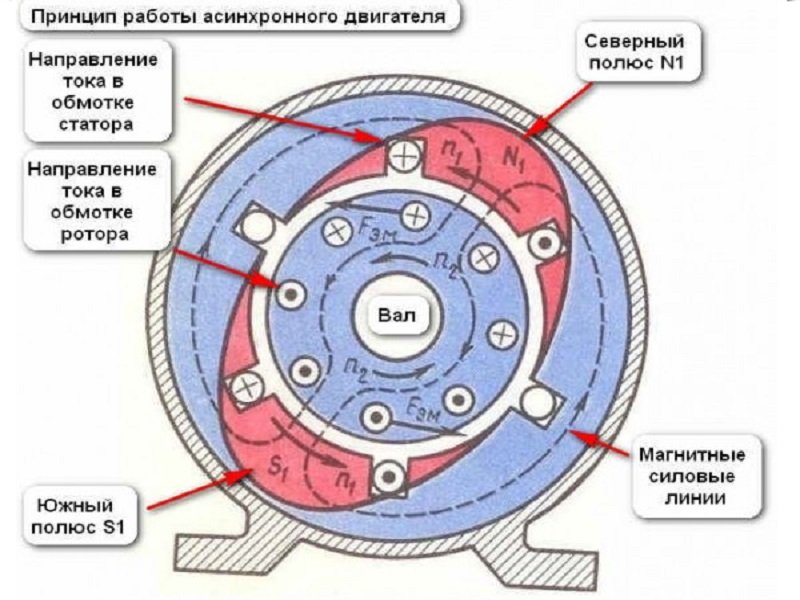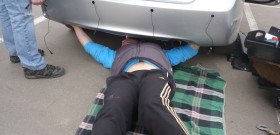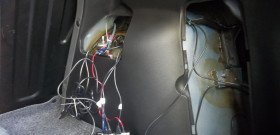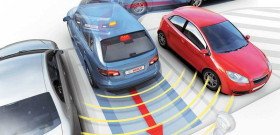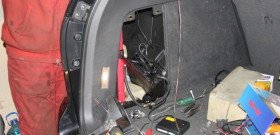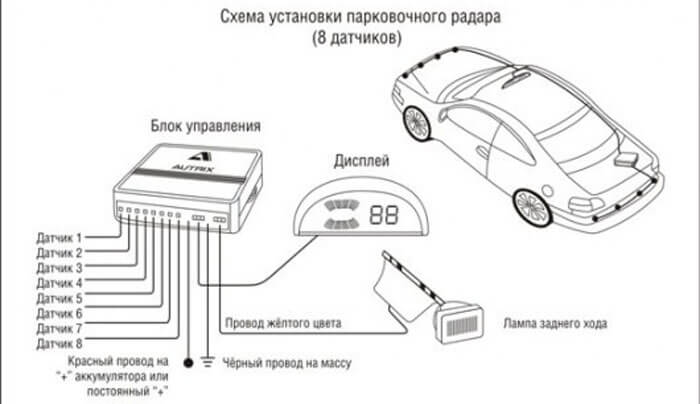
How to install parking sensors with your own hands?
Content
Parktronic or parking radar (sonar) is a device that makes it much easier, especially for a novice driver, to park in difficult urban conditions. Some drivers are skeptical about such an event as installing parking radars. And those who have installed parking sensors already at the factory or later in the service do not regret it at all. Naturally, provided that a high-quality parking sensors are installed.
Briefly about the scheme of operation of parking sensors
The task of the parking sensors is to inform the driver with sound and light signals about the dangerous proximity of any obstacle in the "dead" field of view. It is no longer a novelty of parking sensors equipped with video cameras that display an image on a display or on a windshield.
The schematic diagram of the operation of the parking sensors is the same for any model:
- Sensors 2 to 8 detect an obstacle by means of an ultrasonic signal.
- When an obstacle is detected, the wave returns to the sensor.
- The sensor transmits a signal about the interference through the ECU (electronic control unit), which processes the information.
- Depending on the type of parking sensors, the driver receives: an audible signal, a visual signal, or a complex signal, plus a display of the distance on the LCD display, if available. But, most often, we perceive only the sound signal. Although, who is used to it.
Installing parking sensors yourself
Self-installation of parking sensors is not difficult. It takes time, and, of course, the standard kit itself, which today is in such abundance that it sometimes seems that there are not as many obstacles as parking sensors offer us.
Do-it-yourself parking sensors installation begins with the choice of device. Depending on your wishes and financial possibilities. First, go to the auto forum of your hometown or district and ask the "inhabitants" who and what parking sensors purchased in retail, and how they behave. This will help you make a choice.
The choice has been made, the only thing left is to find out how to install the parking sensors yourself on your model. The fact is that the bumpers of different cars have their own design features. Therefore, in order to avoid picking up a signal from the sky or asphalt, you need to clarify how to properly install the parking sensors on your model.
The instructions for installing the parking sensors in full simply and clearly explain how to connect the parking sensors. These are the instructions that come with the kit. If there is none, or it is not translated, then do not even look in the direction of this device, no matter how attractive the price is. You just buy yourself a flashing toy, and there is no guarantee that it will work.
The parking sensors connection scheme is basically the same for all types of devices. In the kit of the right manufacturer, as a rule, there is already a cutter according to the size of the sensors for making holes in the bumper of the car. Therefore, the question of how to put parking sensors is not worth it.
How to install and connect parking sensors
- Site preparation for installation. The ECU is installed in the trunk. You choose the place yourself. This may be a niche under the skin, or maybe a wing. Not essential.
- Bumper preparation. You need to wash it - this is the first thing. Then markup by the number of sensors. The best option is 4 sensors. The extreme sensors are spaced into the radius parts of the bumper, and then the distance between them is divided into three parts for the remaining two sensors.
- Mark the bumper with an ordinary marker, then it is washed off with alcohol without damaging the bumper paintwork. The markup must be carried out based on the parameters. To do this, there is a parktronic scheme in the kit and its minimum and maximum performance indicators are indicated. The height from the ground is usually 50 cm.
- Using a cutter, we drill holes in the bumper and install the sensors. As a rule, they become ideal in size, but for greater reliability, you can play it safe and put the sensors on glue or silicone.
- Connecting sensors to the computer and then to the monitor is carried out in accordance with the scheme of the partctronic.
- Most importantly, before leaving "on the big road" do not forget to test the parking sensors in different modes and with different obstacles in order to understand when the real signal is coming and why false positives can occur.
When. If you install a homemade parking sensors, the technology for its installation is no different from the factory device. Except for the installation and connection diagram of the ECU, which is assembled by you.


Watch this video on YouTube
Good luck with installing parking sensors with your own hands.
